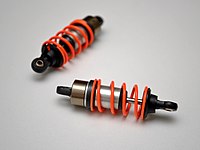
Photo from wikipedia
Abstract Because of the efficiency of semi-active friction dampers to dissipate mechanical energy, their use have been extensively proposed for a variety of mechanical systems to reduce vibration amplitudes. A… Click to show full abstract
Abstract Because of the efficiency of semi-active friction dampers to dissipate mechanical energy, their use have been extensively proposed for a variety of mechanical systems to reduce vibration amplitudes. A considerably simple model for a semi-active friction damper can be obtained with the use of an elastic element coupled to a vibratory system through a variable friction joint. Another approach against excessive vibrations in mechanical structures is the addition of auxiliary mass systems by means of elastic elements and viscous dampers—the auxiliary mass damper (AMD). However, their performance is susceptible to changes in the frequency or form of the excitation force. Therefore, to improve their robustness, it is necessary to design adaptive systems, i.e., adjustable devices that can be used efficiently over a large frequency range. In this work, a semi-active friction damper was used in the auxiliary mass damper’s suspension to tune it by altering the normal force in the friction joint while it dissipates the mechanical energy from the primary vibratory structure. This AMD was named tunable auxiliary mass damper. Furthermore, assemblies using semi-active friction dampers and tunable auxiliary mass dampers were numerically simulated in order to evaluate their effectiveness in the vibration attenuation. Numerical experiments in a multiple-degree-of-freedom vibratory structure were performed and efficiencies of the proposed assemblies were evaluated by means of a performance parameter obtained from their frequency responses. Moreover, their robustness was assessed by imposing several types of excitation forces. Numerical responses that use seismic records as base excitations were obtained for comparison with results in the literature through performance indexes normally used for seismic damage prevention studies. The obtained results presented a promising performance for the selected assemblies that use different positions for friction devices.
Journal Title: Engineering Structures
Year Published: 2019
Link to full text (if available)
Share on Social Media: Sign Up to like & get
recommendations!